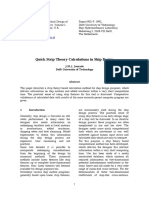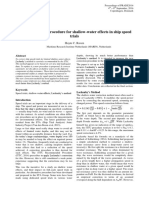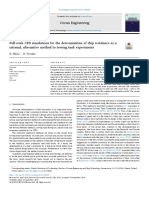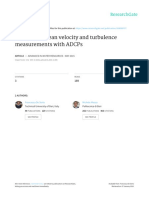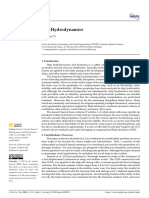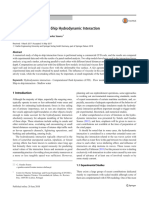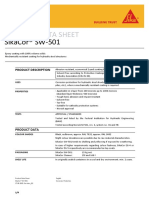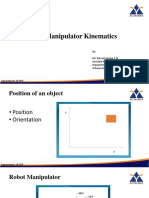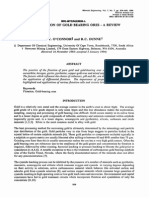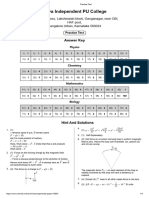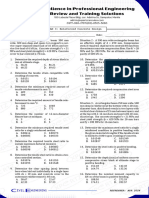Numerical Investigating The Effect
Numerical Investigating The Effect
Uploaded by
ravi_4908Copyright:
Available Formats
Numerical Investigating The Effect
Numerical Investigating The Effect
Uploaded by
ravi_4908Original Title
Copyright
Available Formats
Share this document
Did you find this document useful?
Is this content inappropriate?
Copyright:
Available Formats
Numerical Investigating The Effect
Numerical Investigating The Effect
Uploaded by
ravi_4908Copyright:
Available Formats
POLISH MARITIME RESEARCH 3 (103) 2019 Vol. 26; pp.
56-64
10.2478/pomr-2019-0046
NUMERICAL INVESTIGATING THE EFFECT OF WATER DEPTH
ON SHIP RESISTANCE USING RANS CFD METHOD
Nguyen Thi Ngoc Hoa a
Vu Ngoc Bich a
Tran Ngoc Tu b
Nguyen Manh Chien b
Le Tat Hien c
a
Ho Chi Minh City University of Transport, Vietnam
b
Vietnam Maritime University, Vietnam
c
Hochiminh City University of Technology, Vietnam National University, Vietnam
ABSTRACT
On inland waterways the ship resistance and propulsive characteristics are strictly related to the depth of the waterway,
thus it is important to have an understanding of the influence of water depth on ship hydrodynamic characteristics.
Therefore, accurate predictions of hydrodynamic forces in restricted waterways are required and important. The aim of
this paper is investigating the capability of the commercial unsteady Reynolds– Averaged Navier–Stokes (RANS) solver
to predict the influence of water depth on ship resistance. The volume of fluid method (VOF) is applied to simulate the
free surface flow around the ship. The hull resistance in shallow and deep water is compared. The obtained numerical
results are validated against related experimental studies available in the literature.
Keywords: ship resistance, shallow water, RANS
INTRODUCTION There are three types of methods which are used to
evaluate ship resistance in shallow water: empirical methods,
In general, for a ship moving in shallow water, the following Computational Fluid Dynamics (CFD) methods, and model
phenomena may take place due to the interaction between towing tank tests.
the ship and the seabed [1, 2]: The model tests give the most reliable results in predicting
• water speed around the ship hull increases; ship resistance in comparison with the two other methods.
• pressure gradients around the hull increase; But this technique is both expensive and time consuming,
• dynamic trim and sinkage increase; so it is usually used after the alternative design stage, when
• ship’s wave pattern changes (wave amplitude increases); the overall dimensions and the lines plan of the ship have
• ship resistance increases; already been optimally chosen.
• other ship characteristics (wake field, hull-propeller Some empirical methods, mostly based on towing tank
interaction, maneuverability) change; test results, have been proposed by Artjushkov [3], Geerts
The knowledge of ship resistance when navigating through [4], and Karpov [5], among others, to predict ship resistance
shallow water regions is necessary and important, as correct in shallow water. These methods are fast and do not require
design of ship propulsion system depends on the accuracy in much input data. However, their range of application is often
determining its resistance. limited, and the lack of accuracy is a problem [6].
This paper discusses the influence of water depth on ship Nowadays, fast development of computational resources
resistance, with the aim to make inland vessels operate is making the Computation Fluid Dynamics (CFD) methods
more economically and safely, as well as to reduce their fuel become a powerful tool for ship designers in solving problems
consumption. related to hydrodynamics. Ship resistance calculation is one of
56 POLISH MARITIME RESEARCH, No 3/2019
the basic hydrodynamic problems. The benefit of this method hull, and significant changes in sinkage and trim. All this leads
is that it allows visualization of several quantities, such as to the increase in potential and skin friction drag, together
flow streamlines, wave profiles, or pressure distributions, for with the increase in wave resistance. Using the wave theory,
instance, which are difficult to obtain from experiments. This the wave velocity c can be developed in terms of h and λ,
is a very useful aid for designers to understand the physics where h is the water depth from the still water level and λ is
of flow phenomena, at least from a qualitative point of view. the wavelength, crest to crest. Therefore, classifying the water
Depending on the assumptions made to simplify the as deep or shallow can be decided based on the ratio of water
fluid equations, a number of CFD approaches can be named depth h to wavelength λ.
that are available to solve hydrodynamics problems. These For the deep water, the ratio h/λ is approximately assumed
approaches include: the potential flow theory (panel code), as h/λ ≥ 1/2.
Reynold Averaged Navier-Stokes (RANS) equations, Detached For the shallow water, the ratio h/λ is h/λ ≤ 1/2 and
Eddy Simulation (DES), and Large Eddy Simulation (LES). is known as the critical speed, where c is the wave velocity
DES and LES approaches require much more computational and g is the acceleration gravity.
effort, in terms of meshing and solver time, than the remaining Larsson et al. [1] performed shallow water investigations
two methods, but they allow to capture small variances of in which they presented wave patterns formed due to a point
quantities of interest (velocity and pressure). However, in the source in shallow water. Their work led to the introduction
ship resistance problem we mainly focus on the average values of the dimensionless depth Froude number:
of forces. The RANS method simulates the turbulence using the
term called “turbulence model” and gives time averaged mean (1)
values for velocity and pressure fields. This way, it consumes
less time and requires less computational resources [7].
At the moment, the most popular approach is RANS CFD, SHALLOW WATER EFFECTS
as it ensures sufficient accuracy of results for engineering ON SHIP WAVE PATTERNS
purposes at reasonable computational time. However, the
level of accuracy of the numerical simulation significantly Obviously, the geometry of the ship’s wave pattern in
depends on practical skills. shallow water is not only dependent on its Froude number
There are some authors who performed shallow-water but also on its depth Froude number, which modifies the
CFD calculations to investigate the influence of shallow water wave length and wave components. Based on the value of
on ship resistance. However, large discrepancies between Frh, there are three flow regimes:
CFD and experimental data were witnessed for some results • Sub-critical Frh < 1.0;
obtained by Prakash et al. [8], Pacuraru et al. [9], Patel et al. • Critical Frh = 1.0;
[10], Tezdogan et al. [11]. • Supercritical Frh > 1.0.
This paper presents the theoretical background and The wave system at speeds well below Frh < 1.0, is shown in
application of the RANS method to investigate the effect of Figure 1(a). It comprises the transverse wave system and the
water depth on ship resistance, taking into account the detailed divergent wave system propagating away from the ship. This
setup of simulation to get accurate and meaningful results wave system might be called the Kelvin wave pattern. When the
which agree well with the experiment. The case study is the US ship speed nears the critical speed, Frh = 1.0 the waves become
Navy Combatant DTMB with the available experimental data more perpendicular to the track of the ship, Figure 1(b). At
making it possible to validate the obtained numerical results speeds greater than the critical speed, the diverging wave
on the experiment. The commercial solver Star–CCM+ was system propagates away from the ship with a certain angle,
used in this study. The main objective of the paper is to assess but in this case the transverse waves are clearly visible [1].
the accuracy of CFD simulation for ship resistance calculations
at different water depths.
The paper is organized as follows: the theoretical
background of shallow water effects on ship wave patterns
and ship resistance are described in detail in Section 2. The
numerical simulation is analyzed and discussed in Section 3.
The summary and conclusions are presented in Section 4. a) Sub-critical
THEORETICAL BACKGROUND OF
RESTRICTED WATER EFFECTS ON WAVE
PATTERNS AND SHIP RESISTANCE
When the ship approaches a restricted depth water region,
the interaction begins between the ship and the seabed, which
leads to the velocity increase and pressure decrease under the b) Critical
POLISH MARITIME RESEARCH, No 3/2019 57
NUMERICAL SIMULATIONS
REFERENCE VESSEL
The vessel under study in this paper is the US Navy
Combatant DTMB shown in Figure 4. The main reason for
selecting this hull is that the hull geometry is published [13]
and extensive model test data exists for vessel resistance at
different Froude numbers in shallow and deep water. This data
comes from tests carried out by the Ship Design and Research
c) Supercritical Centre CTO S.A. Poland [14, 15]. To provide opportunities
for direct comparison, the computations were performed at
Fig. 1. Pressure patch wave patterns for different Frh [1] the model scale with scale factor λ = 26.69, the same as the
scale used in model tests.
SHALLOW WATER EFFECTS
ON SHIP RESISTANCE
In order to describe fully the effect of shallow water on ship
resistance, it is usual to use such parameters as T/h or L/h, as
well as the depth Froude number Frh. The influence of shallow
Fig. 4. Geometry of US Navy Combatant DTMB
water on the wave resistance component caused by changes
in the wave pattern has already been investigated by Larsson Tab. 1. Basic parameters of unmanned boats
et al. [1]. The results of the Froude number-based resistance
experiment regarding to L/h changes are shown in Figure 2. Description Ship Model
Scale factor λ – 26.69
Length between perpendiculars LPP(m) 142.0 5.320
Length of waterline LWL(m) 142.18 5.327
Breadth B(m) 19.06 0.714
Draft T(m) 6.15 0.230
Volume (m3) 8425 0.438
Wetted surface S(m2) 2972 4.17
Longitudinal Center of Buoyancy LCB/
Fig. 2. Influence of water depth on residual resistance coefficient [12] From AP LPP 0.489
Figure 3 shows the influence of water depth on the total TEST CASES
resistance coefficient as a function of Froude number and
depth Froude numbers. The computations were performed on the model scale
for the following conditions: design draft TM = 0.23 m
corresponding to the model volume M = 0.455 m3, and LCB
measured from AP equal to 2.602 m in shallow water (water
depth hM = 0.46 m) and in deep water.
The following settings were considered in the simulations:
• Calm water condition;
• Six model scale speeds: 0.597; 0.799, 0.995; 1.199; 1.291,
1.394 m/s for shallow water and deep-water simulations,
corresponding to six depth Froude numbers: 0.281, 0.376,
0.469, 0.564, 0.608, 0.656 for shallow water case.
• The vessel is free to trim and sink;
• The hull mass is constant.
The water parameters for all case studies (density, viscosity)
corresponded to real values used in the experimental set up
(water density ρ = 998.7 kg/m3, kinematic viscosity of water
Fig. 3. Influence of water depth on total resistance coefficient ν = 1.079x10-6 m2/s).
58 POLISH MARITIME RESEARCH, No 3/2019
COMPUTATION SETUP (DFBI) module, which allows the user to select degrees of
freedom in which the analyzed structure can move and rotate.
The commercial package Star-CCM+ from Siemens was For the current study, the ship was free to trim and sink.
used for the computation. Since the ship moves in shallow water, the bottom of the
ship is very close to the seabed boundary. To accurately
Computational domain and boundary conditions model the movement of the ship above the fixed bottom,
The size of computational domain and the boundary the “morphing mesh” was used. When using this mesh, the
conditions are important factors that affect the numerical boundaries of a region can change position and shape over
results. For the computational domain, in general, its size time, due to the motion of the contacting body [16]. Figure 5
should be taken sufficiently large to avoid any wave reflections shows a simple example of the morphing mesh with the flow
from the boundary walls that might affect the numerical through a cylinder with contracting wall.
results. For the ship resistance calculation, the existing flow
symmetry makes that only half of the hull (port side) can be
simulated, thus reducing the computational time. Based on the
recommendations and applications reported in Star-CCM+
[16], the size of the computational domain used in this study
was selected as follows: the inlet boundary was located at 1.5LPP
from forward perpendicular, while the outlet boundary was
located at 2.5LPP from aft perpendicular. The top boundary was
located at 1.5LPP from the free surface, and the lateral boundary
at 2.5LPP from the center plane. The bottom boundaries for
Fig. 5. Example of morphing mesh [16]
shallow-water and deep-water simulations were located at
depth of 0.46 m and 2.5Lpp from the free surface, respectively. Mesh generation
The free surface was located at z = 0. The mesh used in the calculations was composed of
There are several types of boundary conditions offered by hexahedral cells. The meshing and the flow simulation were
the CFD software package. For Star-CCM+, the boundary conducted by Star-CCM+. The grid generated for DTMB
conditions applied when simulating ship resistance in shallow was characterized by concentration of cells around the hull
and deep water are given in Table 2. region near the free surface.
Tab. 2. Boundary Conditions To avoid using a fine mesh where unnecessary, a local
volume was created for the sonar dome, and particular cell
Boundary Shallow water Deep water size was assigned. To capture the exact flow behavior near the
Inlet Velocity inlet Velocity inlet walls of the wetted surface, prism layers were used to resolve
the near-wall flow accurately. The prism layer numbers were
outlet Pressure outlet Pressure outlet selected such as to ensure the average y+ value of 50 on ship
side Symmetry plane Symmetry plane wall boundaries. To capture the flow around the hull near
the free surface, a finer mesh was created in the free surface
Symmetry Symmetry plane Symmetry plane region. The grid at the free surface needed to be small enough
Top Velocity inlet Velocity inlet to capture the wave elevation.
Figure 6 shows the general view of the coarsest mesh for
Bottom Moving No-slip wall Velocity inlet
shallow and deep water.
Ship hull No-slip wall No-slip wall
In the case of shallow water simulation, there is an interaction
between the ship and the seabed. Therefore, the moving No-slip
wall condition was applied on the tank bottom (the bottom
moves with the velocity equal to the ship speed), which is
similar to the CFD simulation successfully performed by Mark
Bettle et. al [17].
Physics modelling
The computation was carried out using the unsteady
Reynold Averaged Navier-Stokes (RANS) equation model.
The free surface was modeled with the volume of fluid
(VOF) method. Fluid turbulence was simulated employing
the Realizable K-epsilon Two-layer model with Two-layer all
y+ wall treatment. To ensure accurate representation of ship
motions, Star-CCM+ offers a Dynamic Fluid-Body Interaction
POLISH MARITIME RESEARCH, No 3/2019 59
2.97 million for deep water. Mesh refinement was done by
reducing the cell size in all directions outside the prism layer.
The idea here was to keep the same y+ values, of about 40 to
60, at near-wall cells over the largest part of the wetted hull
surface for all six cases.
Table 3 presents the total resistance results obtained for
three grids resolutions at V = 1.199 m/s in shallow and deep
water. The difference between the EXP data, denoted as D,
Fig. 6. General view of computational mesh in shallow and deep water and the CFD simulation results, denoted S in this paper, is
defined as:
Selection of time step
One of the key issues determining the numerical accuracy (3)
is the time step. For implicit solvers, the time step is decided
by flow features. For standard pseudo-transient resistance The solution changes obtained in simulations performed
computations, the recommended time step is related to the on two subsequent meshes, such as fine-medium ε12 and
L/V ratio [18]: medium-coarse ε23, are defined as follows:
Δt = 0.005 ~ 0.01 L/V, [s] (2) ε12% = (S1 – S2) / S1; ε23% = (S2 – S3) / S2 (4)
where V [m/s] is the ship speed and L [m] is the characteristic The presented cases show that the resistance changes
length. monotonically with mesh density, and the comparison
shows quite a good agreement between simulation (CFD) and
RESULTS AND DISCUSSION experimental values (EFD), especially for the fine mesh (the
relative error equal to only 3.28% for shallow water simulation
Mesh independency study and 0.47% for deep water simulation). As a result, the fine
The first step of the research was to carry out the mesh mesh was used in further studies.
sensitivity study, i.e. to determine the mesh density at which
the difference between total resistance values obtained from Numerical simulation results
two subsequent meshes reaches a sufficiently low level. The goal Table 4 and Figure 7 compare the predicted and measured
of such a study is to obtain the “grid-independent solution”, total ship resistance values in shallow and deep water for the
i.e. to ensure that further mesh refinement does not improve depth Froude number ranging from 0.281 to 0.656. As can be
the quality of the results. In the presented case, the mesh seen, the difference between the numerically predicted and
sensitivity was studied for shallow water and deep-water cases experimentally recorded ship resistance results varies from
at V = 1.199 m/s. The studies were conducted using three 1.45% to 4.47% for the shallow-water simulation and from
grids with the Non-integer grid refinement ratio rG = 0.47% to 3.57% for the deep-water simulation.
(the value recommended by the ITTC-Quality Manual 7.5- Comparing the values of ship resistance components
03-01-01, 2008 [19]). These grids were referred to as coarse for shallow and deep water is summarized in Table 5 and
(grid#3), medium (grid#2) and fine grid (grid#1), with the Figure 8. As can be seen, two of the resistance components
corresponding cell numbers equal to 0.54, 1.23 and 2.85 increase when the ship moves in shallow water. The change
million, respectively, for shallow water, and 0.65, 1.42 and of the friction resistance component can be explained by the
Tab. 3. Total resistance predicted on different grids at V = 1.199 m/s (Frh = 0.564) in shallow and deep water (Model scale)
Shallow water
V&V Study
Parameter EFD(D) ε32% ε12%
Grid#3 Grid#2 Grid#1
Value 15.291 14.23 14.68 14.79 3.07 0.74
RT[N]
E%D / 6.94 4.00 3.28
Deep water
V&V Study
Parameter EFD(D) ε32% ε12%
Grid#3 Grid#2 Grid#1
Value 12.720 12.98 12.84 12.78 –1.09 –0.47
RT[N]
E%D / –2.04 –0.94 –0.47
60 POLISH MARITIME RESEARCH, No 3/2019
Tab. 4. Comparing predicted ship resistance results with experimental values (model scale)
Parameters V [m/s] 0.597 0.799 0.995 1.199 1.291 1.393
Frh 0.281 0.376 0.469 0.564 0.608 0.656
RT [N] EXP. 4.670 7.282 10.667 15.291 16.695 19.788
in shallow
water
(h = 0.46m) CFD 4.47 7.05 10.28 14.79 16.953 20.08
Relative error [%] 4.47 3.28 3.77 3.39 –1.52 –1.45
EXP. 3.08 5.27 8.25 12.72 14.52 16.98
RT [N]
in deep CFD 3.19 5.45 8.48 12.78 14.78 17.43
water
Relative error [%] 3.57 3.42 2.79 0.47 1.79 2.65
Fig. 7. Comparing predicted ship resistance results in deep and shallow Fig. 8. Changes of ship resistance components
water at different speeds with experimental values in shallow and deep water
Tab. 5. Changes of ship resistance components in shallow and deep water (model scale)
CFD computation in deep water CFD computation in shallow water (h = 0.46m)
V [m/s]
RT RF RP Frh RT RF RP
0.597 3.19 2.80 0.39 0.281 4.47 3.08 1.39
0.799 5.45 4.84 0.61 0.376 7.05 5.14 1.91
0.995 8.48 7.04 1.44 0.469 10.28 7.48 2.80
1.199 12.78 10.18 2.6 0.564 14.79 10.78 4.01
1.291 14.78 11.6 3.18 0.608 16.953 12.316 4.64
1.393 17.43 13.38 4.05 0.656 20.08 14.46 5.62
increasing flow velocity under the keel when the vessel moves water at different depth Froude numbers. The selected
from deep to shallow water. This flow velocity change, clearly ship speed values were the same as in the towing tank
shown in Figure 9, results from the interaction between the experiments performed in CTO [14, 15]. In all analyses,
ship and the seabed. The change of the pressure resistance use was made of the commercial RANS solver Star-CCM+
component can be explained by the change of the wave version 12.02.011.R8.
pattern in shallow water, accompanied by significant pressure The predicted ship resistance and model test results were
drop (see Figures 10 and 11). presented for the DTMB model. The CFD results obtained
for all simulation cases show quite good agreement with
the experiment.
CONCLUSION The increase of ship resistance in shallow water, compared
to the deep-water case at the same speed, is due flow velocity
The unsteady RANS calculations were performed to change under the keel and significant pressure drop along
predict the resistance of the DTMB model in shallow the hull, all this leading to wave pattern change.
POLISH MARITIME RESEARCH, No 3/2019 61
a) Shallow water b) Deep water
Fig. 9. Flow velocity distributions under keel in deep and shallow water, at the same speed (V=1.199 m/s)
a) Shallow water b) Deep water
Fig. 10. Dynamic pressure distributions along the hull in deep and shallow water,at the same speed (V=1.199 m/s)
a) wave patterns at V=0.799 m/s
b) wave patterns at V=1.199 m/s
c) wave patterns at V=1.199 m/s
Fig. 11. Wave patterns at different speeds in shallow and deep water
62 POLISH MARITIME RESEARCH, No 3/2019
5. Karpov, A., Calculation of ship resistance in restricted waters.
TRUDY GII. T. IV, Vol. 2 (in Russian). 1946.
6. Linde, F., et al., Three-Dimensional Numerical Simulation
of Ship Resistance in Restricted Waterways: Effect of Ship
Sinkage and Channel Restriction. Journal of Waterway, Port,
Coastal, and Ocean Engineering, 2016. 143(1): p. 06016003.
7. ITTC 2014 Specialist committee on CFD in marine
hydrodynamics—27th ITTC.
8. Prakash, S. and B. Chandra, Numerical estimation of shallow
Fig. 12. Wave cut at V = 1.199 m/s in shallow and deep water water resistance of a river-sea ship using CFD. International
journal of computer applications, 2013. 71(5).
The computed values of the resistance components
(frictional and pressure) reveal that when the ship moves in 9. Pacuraru, F. and L. Domnisoru. Numerical investigation
shallow water, the pressure resistance component changes of shallow water effect on a barge ship resistance. in IOP
more than the friction resistance component, especially at Conference Series: Materials Science and Engineering. 2017.
high depth Froude numbers. IOP Publishing.
Good agreement between CFD computations and model
tests illustrates the capability of RANS CFD in solving ship 10. Patel, P.K. and M. Premchand, Numerical investigation of
hydrodynamics problems. However, further validation using the influence of water depth on ship resistance. International
model tests with final hull form should be carried out to avoid Journal of Computer Applications, 2015. 116(17).
unexpected errors of numerical methods.
11. Tezdogan, T., A. Incecik, and O. Turan, A numerical
NOMENCLATURE investigation of the squat and resistance of ships advancing
through a canal using CFD. Journal of Marine Science and
B [m] – Ship breadth Technology, 2016. 21(1): p. 86–101.
LPP [m] – Length between perpendiculars
LWL [m] – Length at water level 12. Molland, A.F., S.R. Turnock, and D.A. Hudson, Ship
[m3] – Ship volume displacement resistance and propulsion. 2017: Cambridge university press.
S [m2] – Wetted surface area
T [m] – Ship draft 13. http://www.simman2008.dk/5415/combatant.html.
RT [N] – Total ship resistance
R F [N] – Friction resistance component 14. Resistance test report in deep water for DTMB vessel. CTO,
R P [N] – Pressure resistance component Poland 2017.
h [m] – Depth of water
V [m/s] – Ship speed 15. Resistance test report in shallow water for DTMB vessel. CTO,
Frh – Depth Froude number Poland 2017.
p [kg/m3] – Water density
16. CD-ADAPCO. User Guide STAR-CCM+, Version 13.02.
2018.
REFERENCES
17. Bettle, M., S.L. Toxopeus, and A. Gerber, Calculation of
1. Larsson, L. and H. Raven, Ship resistance and flow. 2010: bottom clearance effects on Walrus submarine hydrodynamics.
Society of Naval Architects and Marine Engineers. International Shipbuilding Progress, 2010. 57(3-4):
p. 101–125.
2. Bertram, V., Practical ship hydrodynamics. 2011: Elsevier.
18. ITTC 2011b Recommended procedures and guidelines
3. Artjushkov, L., Wall effect correction for shallow water 7.5-03-02-03.
model tests. NE Coast Institution of Engineers and
Shipbuilders., 1968. 19. ITTC-Quality Manual 7.5-03-01-01, 2008.
4. Geerts, S., Verwerft, B., Vantorre, M., and Van Rompuy, F.,
Improving the efficiency of small inland vessels. Proc., 7th
European Inland Waterway Navigation Conf., Budapest Univ.
of Technology and Economics, Budapest, Hungary., 2010.
POLISH MARITIME RESEARCH, No 3/2019 63
CONTACT WITH THE AUTHORS
Nguyen Thi Ngoc Hoa
e-mail: hoa_vt@hcmutrans.edu.vn
Vu Ngoc Bich
e-mail: vubich@hcmutrans.edu.vn
Ho Chi Minh City University of Transport
Vietnam
64 POLISH MARITIME RESEARCH, No 3/2019
You might also like
- CFD 2003 - Computational Fluid Dynamics Technology in Ship Hydrodynamics-The Royal Institution of Naval Architects (2003)Document519 pagesCFD 2003 - Computational Fluid Dynamics Technology in Ship Hydrodynamics-The Royal Institution of Naval Architects (2003)lighthilljNo ratings yet
- (Kenneth H. Rose) Project Quality Management WhyDocument9 pages(Kenneth H. Rose) Project Quality Management Whydiana nistoranNo ratings yet
- Ship Resistance Calculation For A Fishing VesselDocument73 pagesShip Resistance Calculation For A Fishing VesselMahdi100% (5)
- Numerical Investigation of Planing Hull Resistance Using Different Turbulence ModelsDocument11 pagesNumerical Investigation of Planing Hull Resistance Using Different Turbulence ModelsalsmoualNo ratings yet
- 68 PDFsam PMRes 2018 Special1 Kulczyk PDFDocument6 pages68 PDFsam PMRes 2018 Special1 Kulczyk PDFNiloy SahaNo ratings yet
- Numerical Investigation of Shallow Water Effect On A Barge Ship ResistanceDocument9 pagesNumerical Investigation of Shallow Water Effect On A Barge Ship ResistancegksahaNo ratings yet
- Quick Strip Theory Calculations in Ship Design: WWW - Shipmotions.nlDocument11 pagesQuick Strip Theory Calculations in Ship Design: WWW - Shipmotions.nlYoungkook KimNo ratings yet
- Quick Strip Theory Calculations in Ship DesignDocument11 pagesQuick Strip Theory Calculations in Ship Designsalman GtrNo ratings yet
- Journee PRADS92 - Quick Strip Theory Calculations in Ship DesignDocument11 pagesJournee PRADS92 - Quick Strip Theory Calculations in Ship Designumair abbasNo ratings yet
- Numerical Investigation On The Effect of Trim On Ship Resistance by RANSE MethodDocument11 pagesNumerical Investigation On The Effect of Trim On Ship Resistance by RANSE Methodheinz billNo ratings yet
- Quick Strip TheoryDocument11 pagesQuick Strip TheoryPopoo KyoNo ratings yet
- A New Correction Procedure For Shallow-Water Effects in Ship Speed Trials - Raven 2016Document9 pagesA New Correction Procedure For Shallow-Water Effects in Ship Speed Trials - Raven 2016Ann Beate DamhaugNo ratings yet
- 10 1016@j Oceaneng 2019 106696Document17 pages10 1016@j Oceaneng 2019 106696Fauzan Kholistya HanifNo ratings yet
- IJME426 CFD Study of Ship-To-Bank InteractionDocument11 pagesIJME426 CFD Study of Ship-To-Bank InteractionIonu MihaiNo ratings yet
- Sea Keeping Analysis For Preliminary DesignDocument10 pagesSea Keeping Analysis For Preliminary DesignTullio OpattiNo ratings yet
- Amecrc PDFDocument17 pagesAmecrc PDFshimul2008No ratings yet
- Fully Coupled BEM-FEM Analysis For Ship Hydroelasticity in WavesDocument29 pagesFully Coupled BEM-FEM Analysis For Ship Hydroelasticity in WavesMarcelo De Oliveira PredesNo ratings yet
- Jmse 11 00852 v2Document23 pagesJmse 11 00852 v2Syed Sdik Siddique Roll twenty four Batch eighteenNo ratings yet
- CFD As A Seakeeping Tool For Ship DesignDocument7 pagesCFD As A Seakeeping Tool For Ship DesignGülsün TezdoğanNo ratings yet
- Ocean Engineering: K. Niklas, H. PruszkoDocument13 pagesOcean Engineering: K. Niklas, H. PruszkoAnthony MarineNo ratings yet
- Catamaran Wetdeck Slamming Loads Using CFDDocument6 pagesCatamaran Wetdeck Slamming Loads Using CFDAhmadA.SwidanNo ratings yet
- Numerical Analysis of FluidDocument16 pagesNumerical Analysis of FluidmundiriNo ratings yet
- Fast97 CouserDocument14 pagesFast97 CouserbrsenerNo ratings yet
- Analysis of Mean Velocity and Turbulence Measurements With AdcpsDocument15 pagesAnalysis of Mean Velocity and Turbulence Measurements With AdcpsHaryo ArmonoNo ratings yet
- Estimation of Hull Girder Vertical Bending Moments Including Non Linear and RDocument14 pagesEstimation of Hull Girder Vertical Bending Moments Including Non Linear and RalfavectorNo ratings yet
- Numericaland Experimental Studyof Blockage Effect Correction Methodin Towing TankDocument16 pagesNumericaland Experimental Studyof Blockage Effect Correction Methodin Towing TankpeppeNo ratings yet
- Jmse 11 00911 v2Document5 pagesJmse 11 00911 v2Rajagopalan GurumurthyNo ratings yet
- 2.an Experimental Study On The Effect of Confined Water On Resistance and Propulsion of An Inland Waterway Ship PDFDocument12 pages2.an Experimental Study On The Effect of Confined Water On Resistance and Propulsion of An Inland Waterway Ship PDFRumen KishevNo ratings yet
- Hydodynamic Loads During The Deployment of ROVs - P.sayerDocument6 pagesHydodynamic Loads During The Deployment of ROVs - P.sayerDavid ThomsonNo ratings yet
- Hydrodynamic Analysis of KVLCC2 Ship Sailing NearDocument16 pagesHydrodynamic Analysis of KVLCC2 Ship Sailing NearSai Sudhakar MNNo ratings yet
- Rationally-Based Fatigue Design of Tankers (Owen Hughes and Paul FranklinDocument17 pagesRationally-Based Fatigue Design of Tankers (Owen Hughes and Paul FranklinKelvin XuNo ratings yet
- On The Importance of Full-Scale CFD Simulations For Ships - ArticleDocument11 pagesOn The Importance of Full-Scale CFD Simulations For Ships - ArticlemarinkorijekaNo ratings yet
- FulltextDocument177 pagesFulltextebinjohnsonNo ratings yet
- Motion Predictions of Ships in Actual Operating CoDocument13 pagesMotion Predictions of Ships in Actual Operating Coelmariner.24No ratings yet
- Evaluation of Resistance Increase and Speed Loss of A Ship in Wind and WavesDocument7 pagesEvaluation of Resistance Increase and Speed Loss of A Ship in Wind and WavesCarlos HernándezNo ratings yet
- Szelangiewicz-Zelazny An Approximate 60-2019Document8 pagesSzelangiewicz-Zelazny An Approximate 60-2019Mohamad JammalNo ratings yet
- A Numerical and Experimental Study of Resistance, Trim and Sinkage of An Inland Ship Model in Extremely Shallow WatereDocument8 pagesA Numerical and Experimental Study of Resistance, Trim and Sinkage of An Inland Ship Model in Extremely Shallow WatereTat-Hien LeNo ratings yet
- Added Resistance, Heave and Pitch For The KVLCC2 Tanker Using A Fully Nonlinear Unsteady Potential Flow Boundary Element MethodDocument14 pagesAdded Resistance, Heave and Pitch For The KVLCC2 Tanker Using A Fully Nonlinear Unsteady Potential Flow Boundary Element MethodFlorin PacuraruNo ratings yet
- 2007 Katrine Wave-In-Deck Loading On Fixed Steel Jacket Decks1-S2.0-S0951833907000330-MainDocument21 pages2007 Katrine Wave-In-Deck Loading On Fixed Steel Jacket Decks1-S2.0-S0951833907000330-Mainklop disposableNo ratings yet
- Planing in Extreme Conditions - Blount, Funkhouser 2009Document14 pagesPlaning in Extreme Conditions - Blount, Funkhouser 2009haujesNo ratings yet
- Seakeeping Methods Lecture - Alto UniversityDocument35 pagesSeakeeping Methods Lecture - Alto UniversityajayNo ratings yet
- Brochure 2017 - MIT 2NDocument26 pagesBrochure 2017 - MIT 2Njwpaprk1No ratings yet
- Comparison Between The Dynamic Behavior of The Non-Stepped and Double-Stepped Planing Hulls in Rough Water: A Numerical StudyDocument16 pagesComparison Between The Dynamic Behavior of The Non-Stepped and Double-Stepped Planing Hulls in Rough Water: A Numerical StudyGerasimos FragopoulosNo ratings yet
- Processes: Study On Hull Optimization Process Considering Operational Efficiency in WavesDocument21 pagesProcesses: Study On Hull Optimization Process Considering Operational Efficiency in WavesSahil JawaNo ratings yet
- Molland-Insel Regression Method For CatamaransDocument15 pagesMolland-Insel Regression Method For CatamaransTihomir MarkovicNo ratings yet
- CFD Investigation Into The Wave Added Resistance of Two ShipsDocument20 pagesCFD Investigation Into The Wave Added Resistance of Two ShipsSahil JawaNo ratings yet
- Air Cavity Under Stepped Planing Hull - StudyDocument27 pagesAir Cavity Under Stepped Planing Hull - Studytan.shannon98No ratings yet
- The Hydrodynamics Performance of Aquaculture Fishing Vessel in Variation of Deadrise Angle and SponsonDocument10 pagesThe Hydrodynamics Performance of Aquaculture Fishing Vessel in Variation of Deadrise Angle and SponsonTJPRC PublicationsNo ratings yet
- Wnk2018 Article CFDAnalysisOfShip-To-ShipHydroDocument18 pagesWnk2018 Article CFDAnalysisOfShip-To-ShipHydroIszysax MediaNo ratings yet
- Length Beam RatioDocument12 pagesLength Beam Rationisar ahmedNo ratings yet
- Estimation of Added Resistance and Ship Speed Loss PDFDocument12 pagesEstimation of Added Resistance and Ship Speed Loss PDFAnant AjithkumarNo ratings yet
- CFD Analysis of Ship-To-Ship Hydrodynamic InteractionDocument17 pagesCFD Analysis of Ship-To-Ship Hydrodynamic InteractionfauzanhanifNo ratings yet
- Study of Passing Ship Effects Along A Bank by Delft3D-Flow and XbeachDocument10 pagesStudy of Passing Ship Effects Along A Bank by Delft3D-Flow and XbeachCarlosNo ratings yet
- Estimation of Added Resistance and Ship Speed Loss in A SeawayDocument12 pagesEstimation of Added Resistance and Ship Speed Loss in A SeawayJoaNo ratings yet
- A Practical Analysis of Sea Breeze Effects on Coastal Areas: (with Implications Associated with Renewable Energy Applications and Environmental Assessments)From EverandA Practical Analysis of Sea Breeze Effects on Coastal Areas: (with Implications Associated with Renewable Energy Applications and Environmental Assessments)No ratings yet
- Wave and Tidal EnergyFrom EverandWave and Tidal EnergyDeborah GreavesNo ratings yet
- Light 7 QP - 240314 - 053508Document9 pagesLight 7 QP - 240314 - 053508diyanooooooorNo ratings yet
- Astm A 1011-07Document8 pagesAstm A 1011-07Mauricio Salinas BeltranNo ratings yet
- Programmi Svolti PythonDocument84 pagesProgrammi Svolti PythonGrezooNo ratings yet
- Selection of Induction MotorsDocument5 pagesSelection of Induction MotorsadauNo ratings yet
- SikaCor SW-501 - EN - CDocument4 pagesSikaCor SW-501 - EN - CMark InnesNo ratings yet
- Lecture2 v1Document36 pagesLecture2 v1Kathérine JosephNo ratings yet
- Heat Exchanger (Parallel and Counter Flow)Document5 pagesHeat Exchanger (Parallel and Counter Flow)ommech2020100% (1)
- A First Course in Chaotic Dynamical Systems: Theory and ExperimentDocument3 pagesA First Course in Chaotic Dynamical Systems: Theory and ExperimentÜbel L RENo ratings yet
- Differential EquationsDocument9 pagesDifferential EquationsMizanur RahmanNo ratings yet
- M2 - Robot KinematicsDocument47 pagesM2 - Robot KinematicsN BHUSHANNo ratings yet
- Cerium OxideDocument7 pagesCerium OxideSuhayb Imtiyaz100% (1)
- BIOBASE Vortex Mixer MX-S MX-F MX-M User ManualDocument12 pagesBIOBASE Vortex Mixer MX-S MX-F MX-M User Manualsoporte03No ratings yet
- Catalogo Vent-O-Mat RBXCDocument16 pagesCatalogo Vent-O-Mat RBXCfrmalthusNo ratings yet
- (Bertrand - Duplantier, - Vincent - Rivasseau - (Eds.) ) - Henri Poincaré 1912-2012Document246 pages(Bertrand - Duplantier, - Vincent - Rivasseau - (Eds.) ) - Henri Poincaré 1912-2012Federico RicaldeNo ratings yet
- BookDocument725 pagesBookYehor100% (1)
- 2.1 SSDocument3 pages2.1 SSJaylanGalasiNo ratings yet
- Carbon Filament LampDocument9 pagesCarbon Filament LampPahi Saharia100% (1)
- A1a, B1a, D1a PDPL 0318materialDocument1 pageA1a, B1a, D1a PDPL 0318materialrami ghorbelNo ratings yet
- Crusher Bearings Technical White PaperDocument6 pagesCrusher Bearings Technical White PaperApna BharatNo ratings yet
- The Flotation of Gold Bearring Ores - A Review PDFDocument11 pagesThe Flotation of Gold Bearring Ores - A Review PDFromanangelhernandez100% (1)
- Hoya Product Booklet-FinalDocument16 pagesHoya Product Booklet-FinaladeenNo ratings yet
- Monolithic Dome ConstructionDocument10 pagesMonolithic Dome Constructionnithya kjNo ratings yet
- Separation of Ethyl Acetate and Butyl Acetate by Simple Distillation and Analysis of Fractions by GasDocument9 pagesSeparation of Ethyl Acetate and Butyl Acetate by Simple Distillation and Analysis of Fractions by GasMunna Patel100% (1)
- Practice Test Student SolutionsDocument4 pagesPractice Test Student Solutionsreemkhalifah786No ratings yet
- Estimating The Low-Speed Sidewash PDFDocument3 pagesEstimating The Low-Speed Sidewash PDFGabriel Rodrigues FelixNo ratings yet
- Soil Nailing - Design Nail StabilisationDocument93 pagesSoil Nailing - Design Nail Stabilisation류태하100% (4)
- PSAD 3 Reinforced Concrete DesignDocument7 pagesPSAD 3 Reinforced Concrete Designjacobsantos054No ratings yet
- Quad ModelsDocument3 pagesQuad ModelsmicrovacNo ratings yet
- Electricity and Circuits VI CLASSDocument7 pagesElectricity and Circuits VI CLASSsrinav sNo ratings yet
- Quality Assurance For ConcreteDocument4 pagesQuality Assurance For ConcretePreethi SekarNo ratings yet








